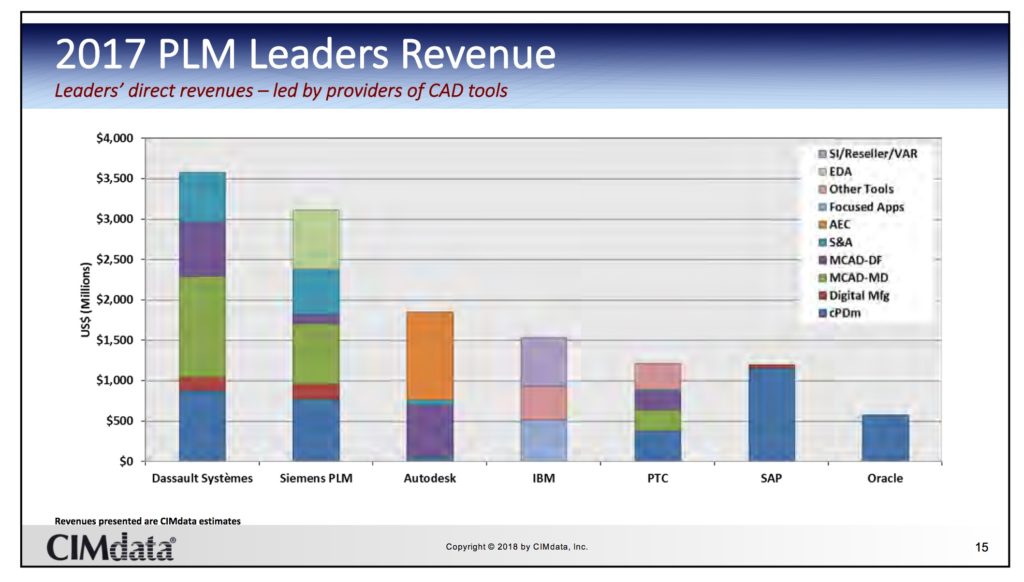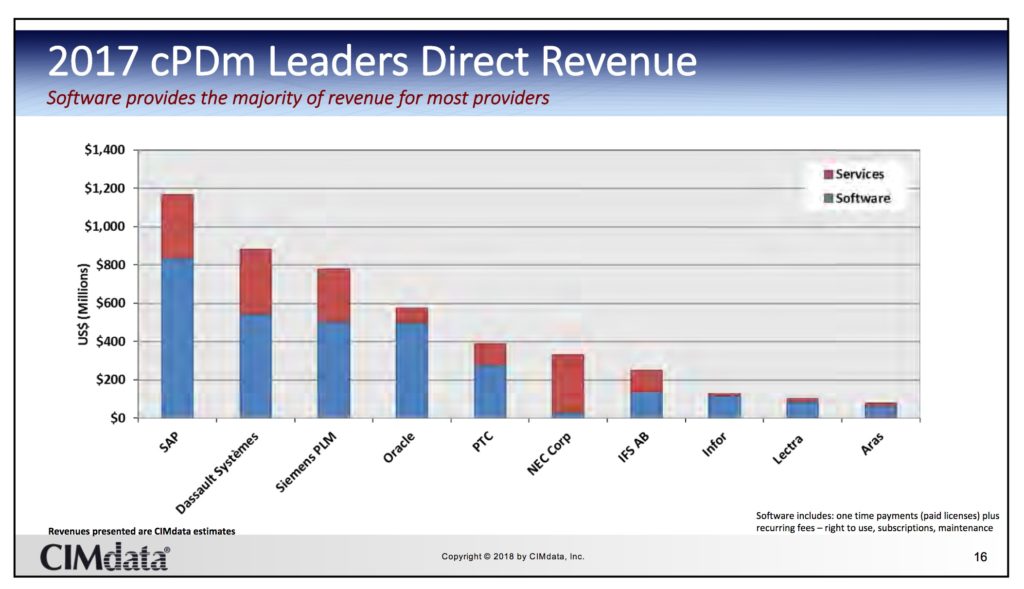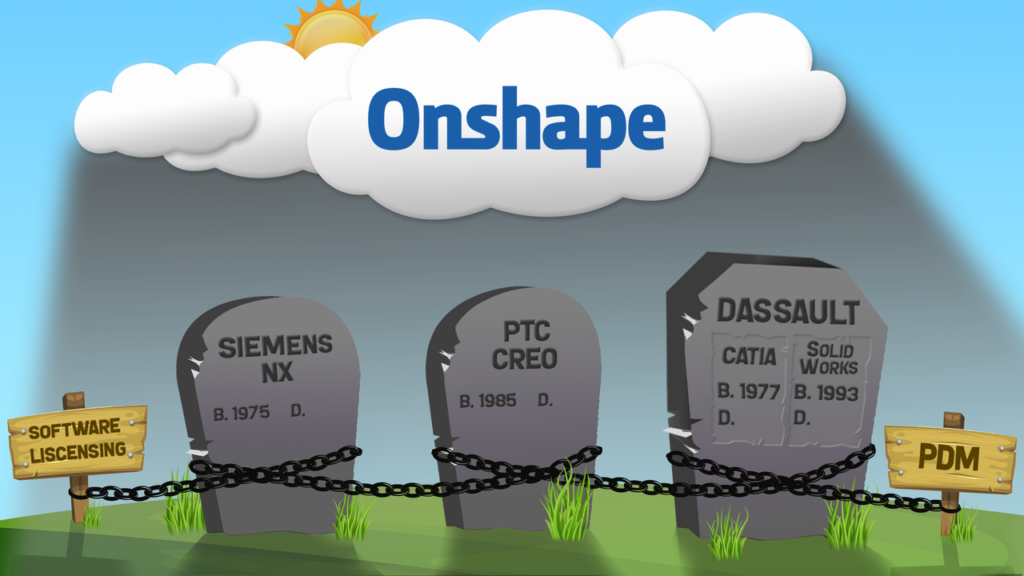
I attended The State of PLM economy webinar organized by CIMdata – leading source of information and analytics about PLM market. Stan Przybylinski, CIMdata Vice President shared latest PLM market data, trends and company news. You can register to webinar and get information here. The quick summary in 2 slides.
PLM revenues by leading vendors in 2017.

cPDM leaders direct revenues

The youngest companies on the list are 15-20 years old. CIMdata presentation made me think about status quo of large and established CAD and PLM companies, their high and low moments and people that were involved in building of these companies. Is there a way to disrupt business of these companies? Is there an opportunity to create a new company capable to change a status quo in the industry.
Aras is clearly one of the most visible candidates to change PLM business status quo. I hope you had a chance to read my blog earlier this week – Why it takes 18 years to build enterprise PLM startup. As much as I like Aras potential, CAD & PLM companies are built on the foundation of established design technologies with core revenues coming from design software licenses. Who and how can disrupt these CAD technologies and products? Can disruption be done by people that know all about these vendors and their business?
According to Steve Stachen, Onshape is the company and product that will make that change. Steve is new VP of Enterprise Sales at Onshape. He wrote few interesting personal articles on his LinkedIn page – My path to Frustum and the people who led me there and On to Onshape.
I totally agree with Steve about the role of people. He brought few very personal examples of people standing behind big moments in the industry and fundamental changes in technological and product landscape. Steve’s article reminded me Steve Jobs’ wisdom -“It doesn’t make sense to hire smart people and then tell them what to to , We hire smart people so they can tell us what to do.” Another version of the same message – “Kadry reshayut vse” by Joseph Stalin. Here is a passage (Google translated) from the (1937) article.
…So, comrades, if we want to eliminate hunger in the field of people with success and to ensure that our country has a sufficient number of personnel capable of moving the equipment forward and putting it into action, we must first learn how to appreciate people, appreciate people. an employee who can benefit our common cause. It is necessary, finally, to understand that of all the valuable capital available in the world, the most valuable and most crucial capital is people, personnel… [J. Stalin]
A picture worth thousand words. I captured this picture from Steve’s article. Cemetery of with tombs ready to get existing CAD vendors covered by Onshape cloud hiding the sun.

According to the article, young generation of engineers will not decide for old CAD systems with outdated licenses and complex PDM systems. Steve brings his daughter as an example of future engineers. Here is a passage speaking about that.
Here’s the interesting thing, however. If Gaby were to enter the workforce today as a newly graduated mechanical engineer, even if she went to any of the most progressive, engineering-centric companies in the world, invariably, she would be entering the bizarre, eclectic world of on-premise CAD. In this old world, Gaby would have to unlearn everything she knows about accessing and using applications, sharing content, and collaborating with other humans. The familiar IT security posture that has always protected her in her private life will vanish from her work life. She would have to learn archaic workflows defined by the limits of 40-year-old technology. She would have to use software tools that were developed during Ronald Reagan’s Administration.
Both articles made me think about enterprise competition. It is multi-factor game combined from software, technologies, but most importantly people. One of the most successful ways to compete in enterprise software is to get to the moment when people that took IT and software decision in the previous round are leaving the building. Technologies are getting old, but if people that standing behind these technologies are still supporting them, to replace these products can be a tough job. Economical factor can play a role. This is how Aras “overnight success” was build on top of 10 years of free downloads and slow seeding and adoption of technologies by companies with right teams sensitive to high cost of traditional solutions.
What is my conclusion? Onshape established cloud technologies and product with huge potential and differentiation. And Onshape is changing trajectory to put significant focus behind cloud PDM and Enterprise solutions. The competitors are major CAD vendors – NX, PTC Creo, CATIA. What is the formula of potential Onshape enterprise success? Is it about cost? Can Onshape build an alternative business model to provide Onshape product for free like Aras did? How enterprise value of Onshape will be combined with CAD technologies and features to become a platform of choice for young generation of engineers to replace CATIA, PTC Creo and NX? Onshape will have to answer on all these questions. According to Steve Stachen, he was fortunate to have his Forrest Gump moments in the past. Onshape has a great team of established leaders. I’m sure 2019 will be an interesting year to watch Onshape product development and team trajectories. Just my thoughts…
Best, Oleg
Disclaimer: I’m co-founder and CEO of OpenBOM developing cloud based bill of materials and inventory management tool for manufacturing companies, hardware startups and supply chain. My opinion can be unintentionally biased
The post CAD: Cloudy With Chances for Forrest Gump Moments appeared first on Beyond PLM (Product Lifecycle Management) Blog.



Be the first to post a comment.